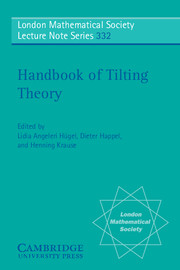Book contents
- Frontmatter
- Contents
- 1 Introduction
- 2 Basic results of classical tilting theory
- 3 Classification of representation-finite algebras and their modules
- 4 A spectral sequence analysis of classical tilting functors
- 5 Derived categories and tilting
- 6 Hereditary categories
- 7 Fourier-Mukai transforms
- 8 Tilting theory and homologically finite subcategories with applications to quasihereditary algebras
- 9 Tilting modules for algebraic groups and finite dimensional algebras
- 10 Combinatorial aspects of the set of tilting modules
- 11 Infinite dimensional tilting modules and cotorsion pairs
- 12 Infinite dimensional tilting modules over finite dimensional algebras
- 13 Cotilting dualities
- 14 Representations of finite groups and tilting
- 15 Morita theory in stable homotopy theory
- Appendix: Some remarks concerning tilting modules and tilted algebras. Origin. Relevance. Future.
11 - Infinite dimensional tilting modules and cotorsion pairs
Published online by Cambridge University Press: 25 May 2010
- Frontmatter
- Contents
- 1 Introduction
- 2 Basic results of classical tilting theory
- 3 Classification of representation-finite algebras and their modules
- 4 A spectral sequence analysis of classical tilting functors
- 5 Derived categories and tilting
- 6 Hereditary categories
- 7 Fourier-Mukai transforms
- 8 Tilting theory and homologically finite subcategories with applications to quasihereditary algebras
- 9 Tilting modules for algebraic groups and finite dimensional algebras
- 10 Combinatorial aspects of the set of tilting modules
- 11 Infinite dimensional tilting modules and cotorsion pairs
- 12 Infinite dimensional tilting modules over finite dimensional algebras
- 13 Cotilting dualities
- 14 Representations of finite groups and tilting
- 15 Morita theory in stable homotopy theory
- Appendix: Some remarks concerning tilting modules and tilted algebras. Origin. Relevance. Future.
Summary
Classical tilting theory generalizes Morita theory of equivalence of module categories. The basic property – existence of a maximal category equivalence represented by the tilting module – forces the module to be finitely generated, cf. [31, §2], [85].
However, some aspects of the classical theory can be extended to infinitely generated modules over arbitrary rings. In this paper, we investigate such an aspect in detail: the relation of tilting to approximations (preenvelopes and precovers) of modules. Then we show how infinitely generated tilting modules are employed for proving finitistic dimension conjectures in particular cases, and for characterizing Matlis localizations of commutative rings.
General existence theorems provide a big supply of approximations in the category Mod–R of all modules over an arbitrary ring R. However, the corresponding approximations may not be available in the subcategory of all finitely generated modules. So the usual sharp distinction between finitely and infinitely generated modules becomes unnatural, and even misleading.
Cotorsion pairs give a convenient tool for the study of module approximations. Tilting cotorsion pairs are defined as the cotorsion pairs induced by tilting modules. We present their characterization among all cotorsion pairs, and apply it to a classification of tilting classes in particular cases (e.g., over Prüfer domains). The point of the classification is that tilting classes coincide with classes of finite type.
Information
- Type
- Chapter
- Information
- Handbook of Tilting Theory , pp. 279 - 322Publisher: Cambridge University PressPrint publication year: 2007
Accessibility standard: Unknown
Why this information is here
This section outlines the accessibility features of this content - including support for screen readers, full keyboard navigation and high-contrast display options. This may not be relevant for you.Accessibility Information
- 16
- Cited by
